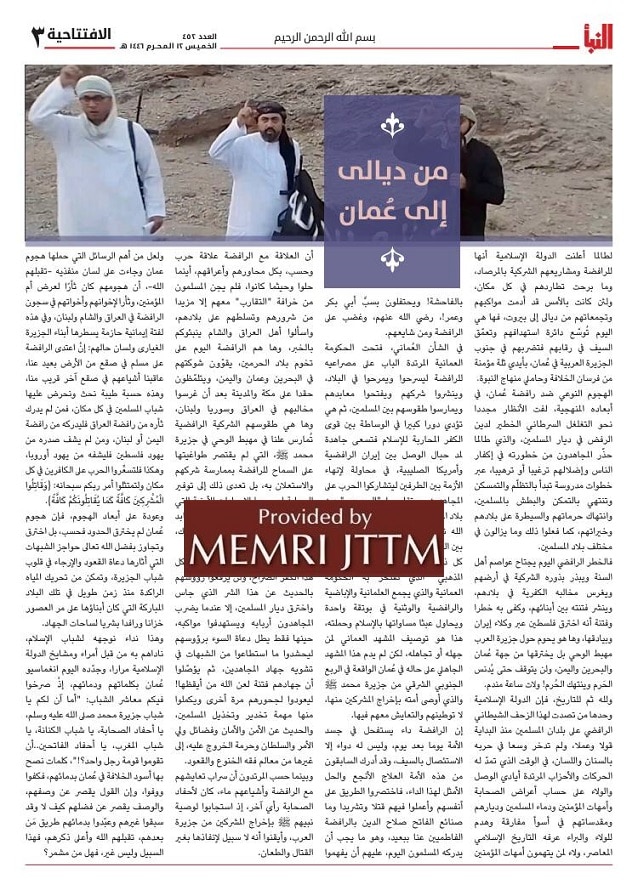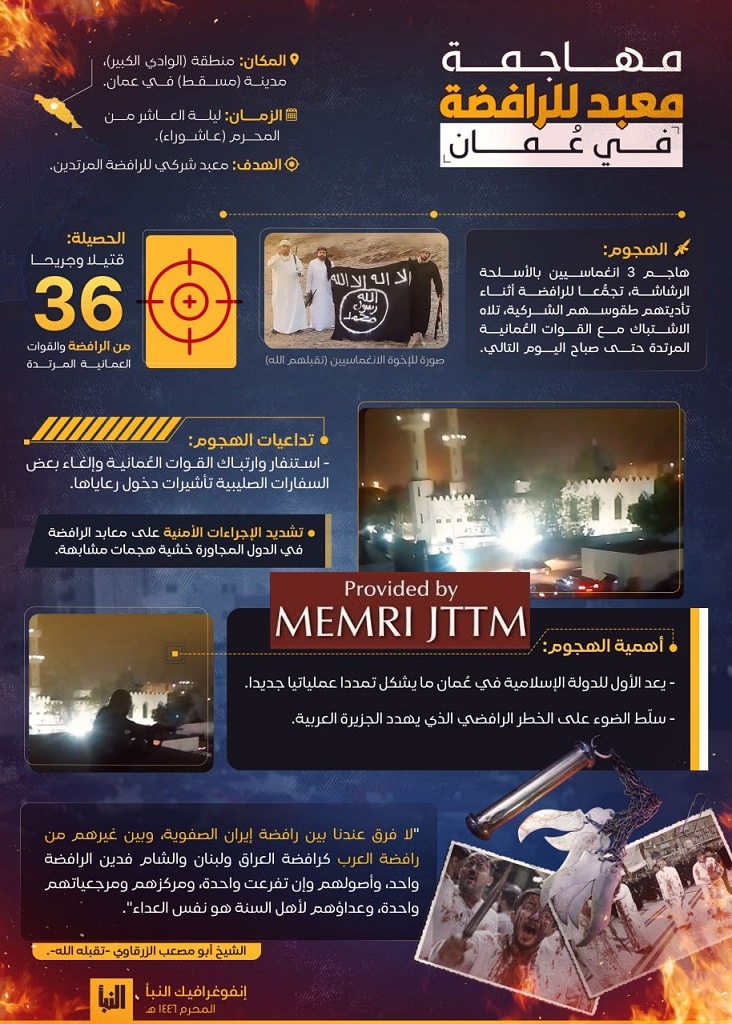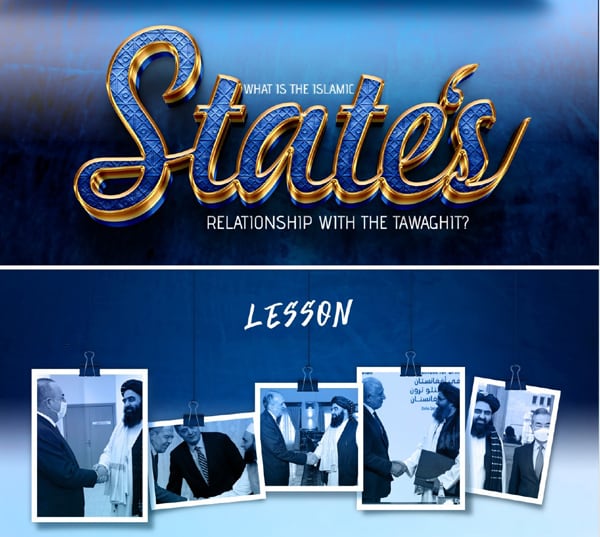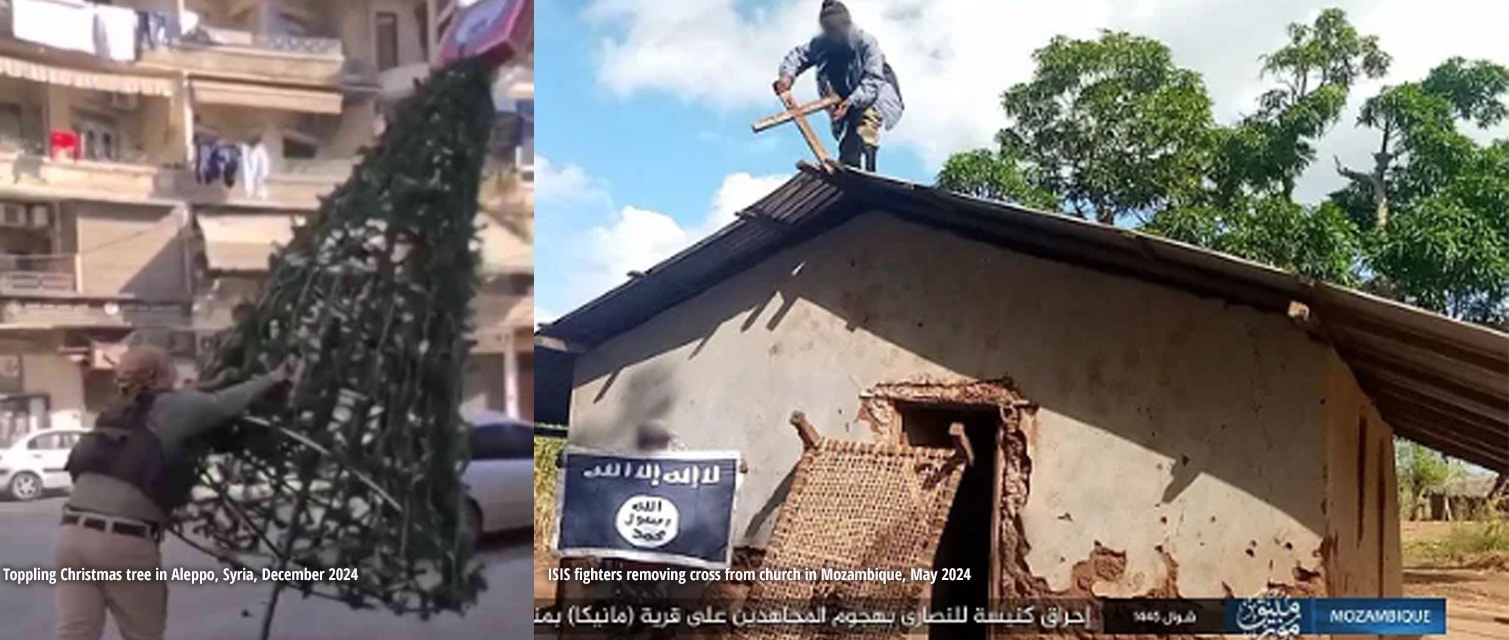The following report is now a complimentary offering from MEMRI's Jihad and Terrorism Threat Monitor (JTTM). For JTTM subscription information, click here.
On July 18, 2024, the Islamic State (ISIS) released Issue 451 of its weekly newsletter, Al-Naba'. The issue's feature article, titled "From Diyala To Oman," celebrates the July 15 attack in Muscat, Oman, as a continuation of ISIS's declared war on Shi'ite Muslims, and an expansion of the scope of ISIS attacks to counter the Iran-spearheaded "polytheistic projects" in the region.
On July 16, 2024, ISIS's A'maq News Agency claimed responsibility for a previous-day attack on a Shi'ite mosque in Muscat. "More than 35 Shi'ites and members of Omani security forces" were wounded and killed in the attack, according to the statement. The attack in the Gulf Sultanate was the first ever claimed by the group.
Subsequently, A'maq released video featuring the perpetrators of the July 15 attack outlining the motives behind the attack, and imploring young Muslims in Egypt, the Arabian Peninsula, and Morocco to revolt against "the armies" of their countries which were established to suppress Muslims and "protect the state of the Jews [Israel]."
The editorial begins by highlighting that the recent attack in Oman re-directed attention towards the threat of the "fast-growing cancer of the religion of Rafd [derogatory for Shi'ism]" in Muslim lands.
"Today, the Rafidi threat is sweeping Sunni capitals, sowing the seeds of polytheism and nonbelief, and spreading sedition among people of the same area…How dangerous could it ever be as it has penetrated Palestine through Iran's agents and minions," the article stated. It also warned that the Iran-led expansionism in the area continues to penetrate the Arabian Peninsula, through Oman, Bahrain, and Yemen.
According to the editorial, ISIS was the only party that confronted the "satanic encroachment" on Muslim countries from the beginning, with words and actions. During this time, it adds, "apostate" Islamic movements have been building ties and extending loyalty to Iran at the expense of Sunni populations and the honor of revered ancestors.

Omani Government's Role In Region Allows U.S. And Iran To "Share War On The Mujahideen" And "Take A Slice Of Muslim Land"
Discrediting the style of government in Oman, the editorial claims that the Gulf nation is not only disrupting sharia, and allowing Iran to roam freely in the country to, the piece asserts, promote polytheism. Iran also plays a major role in mediating between the forces of nonbelief fighting Islam, and "strives to maintain a connection between Rafidi Iran and Crusader America." The editorial argues that the Omani government works to end the crisis between the Iran and the United States so that they "share the war on the mujahideen and take a slice of Muslim land."
The piece argues that the Omani landscape includes the unification of secularism, Ibadi and Rafidi [Shi'ism], and pagan religion in one vessel. This vain attempt to equate all religions with Islam and its champions, the piece continues, is a clear depiction of the Omani scene, which the government boasts about. At the same time, people fail to see that Oman is part of the Arabian Peninsula, which the Prophet commanded must be purged of polytheists, per a related hadith, the article asserts.
Sunnis Must Understand That Any Relationship With Shi'ites Is A Relationship Of War
According to Al-Naba', Shi'ites are "a disease that metastasizes in the body of the nation of Islam"; the one and only remedy is to remove it "by the force of the sword." It asserts that Sunni Muslims must understand that the relationship with Shi'ites of all ethnicities and factions, and wherever they exist, is a "relationship of war." The editorial notes that Muslims reaped no positive outcomes from the "myth of coexistence" with Shi'ites except vindictiveness and loss of dominance over Muslim land.
Additionally, the editorial discredits Sunni scholars for their silence on the spread of Shi'ites' "nonbelief," noting that the "preachers of evil" voice concern only following jihadi attacks. These preachers spread fabrications to defame the mujahideen and jihad as a seditious approach, the piece states, while praising the virtues of the "custodian" and the "Sultan" prohibiting rebellion against rulers, among other aspects of the "jurisprudence of submission and indolence":
"While the apostates thought that the mirage of coexistence with Shi'ites is an established reality, the descendants of the Companions [of the Prophet Muhammad] had a different opinion, as they responded to their Prophet's command to expel the polytheists from the Arabian Peninsula, and they were certain that there was no way to implement the command without fighting and bloodshed."
ISIS Sets New "Equation": Attacks By Shi'ites Against Sunnis In One Area Should Be Punished By Targeting Shi'ites Nearby
The editorial claims that the message of the attack of Muscat, being a vengeful act in support of ISIS prisoners in Iraq, Syria, Lebanon, and Yemen, represents a firm "gesture of faith" by the proud people of the Arabian Peninsula. The attack makes a clear statement: if Shi'ites target one Muslim in one area, other Shi'ites in a nearby territory would be punished for the attack.
"This is a plausible equation we encourage and incite young Muslims everywhere to embrace," the piece declares, adding: "Whoever does not exact revenge on Rafidis in Iraq, can heal their heart targeting Rafidis in Yemen or Lebanon, and whoever cannot heal their heart from the Jews of Palestine, let them do so targeting the Jews of Europe…Thus, wage war against the unbelievers in every way."
Discussing the repercussions of the attack in Oman, the editorial stresses that it not only crossed the physical border, but also shattered the barriers of ant-jihadi suspicions propagated by scholars affiliated with regimes in the region, and moved the long-stagnant waters in the blessed land.
To conclude, Al-Naba' piece addresses the youth of Islam in the Arabian Peninsula, Egypt, and the Maghreb region, reiterating messages repeatedly launched by ISIS in the past, and today answered with the blood of Omani ISIS adherents, urging them to rise up as one man.
Infographic: Attack In Oman Caused Security Confusion In Region And Represents "A New Operational Expansion"
Shedding more light on the attack in Muscat, Issue 451 of Al-Naba' also featured an infographic, claiming the attack was against a "polytheistic shrine," which killed or wounded 36 people, caused a state of confusion, and made some Western embassies cancel visas for their citizens.
The infographic praises the first attack ever in Oman, calling it a new operational expansion, and claiming it shed light on the Rafidi threat targeting the Arabian Peninsula.
The infographic cites slain figure of jihad in Iraq, Abu Mus'ab Al-Zarqawi, as saying the Islamic State does not differentiate between "Safavid" Iranian Shi'ites and their equals among Arabs in Iraq, Lebanon, and Syria: "The religion of the Rafidis is one, and their roots, even diversified, remain the same. Their center and reference are one and their enmity to Sunnis is the same."

The full text of this post is available to subscribers.
Please login or register to request subscription information from MEMRI






